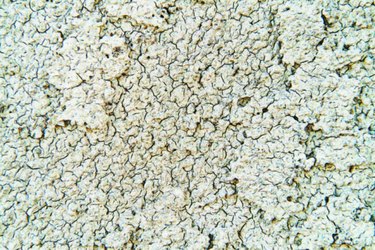
Mold is everywhere in our environment and begins to grow when airborne spores land in areas that remain wet constantly. Twenty-four to 48 hours after mold spores land on moisture, mold begins to grow. Any mold growing in your home is cause for concern and should be removed. Those with allergies to mold or respiratory diseases should not attempt to remove mold, as large numbers of spores become airborne during cleaning which can cause an adverse reaction in some people.
Identification
Video of the Day
Molds are an integral part of our environment, helping to break down decaying organic matter outdoors. Mold growing indoors can have adverse effects on some people's health. Mold spores are the way mold reproduces and they float in the air around us everyday. These fungal spores do not need to be live to cause health problems in people who are sensitive to mold. According to the University of Florida, IFAS Extension, airborne dead mold spores can cause allergic reactions in some people the same way live mold spores can.
Video of the Day
Effects
Once mold spores enter your home and find a source of moisture, they begin to grow. If mold is present in your home, a certain amount of mold spores are floating in the air. Mold spores are small and are breathed into the lungs, causing allergic reactions to develop. Allergic reactions to mold spores often cause itching eyes, nasal congestion, coughing, sneezing, wheezing, difficulty breathing, hives or skin rash. It can also trigger asthma attacks in those with asthma or other respiratory conditions. If you can smell or see mold inside your home, there are mold spores in the air that can make you sick.
Removal
The Environmental Protection Agency (EPA) recommends you remove it or have it removed by a mold removal specialist. You can remove small patches of mold with liquid dish soap or bleach solutions. Removing mold causes a large number of mold spores to become airborne at once. While certain cleaners such as bleach kill mold spores on surfaces, they does not kill airborne spores. Scrub mold with liquid dish soap and water or a combination of bleach and water. After scrubbing, rinse with water and dry with a soft cloth. After removing mold from your home, you must find the source of moisture and repair it so that the mold does not return.
Considerations
Removing mold causes mold spores to become airborne in great quantities, causing adverse effects in some people. While cleaning, minimize your exposure to mold spores by wearing goggles, a mask, shoes, pants and long sleeves. While removing mold, keep all elderly people, immune-compromised people and young children away from the area.